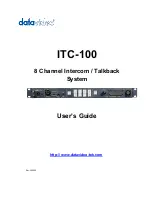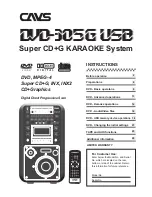
3
CX-JDS22/JDS33
TABLE OF CONTENTS
1.
GENERAL
...................................................................
4
2.
DISASSEMBLY
2-1. Disassembly Flow ...........................................................
6
2-2. Top Panel, Side Panel ...................................................... 7
2-3. Front Section ...................................................................
7
2-4. CD Mechanism Section ...................................................
8
2-5. Cassette Mechanism Deck, PAI/HP/MIC Board .............
8
2-6. PANEL Board .................................................................. 9
2-7. Rear Cabinet .................................................................... 9
2-8. Power Board .................................................................... 10
2-9. MAIN Board, AMP Board .............................................. 10
2-10. Holder (CD Mechanism) ................................................. 11
2-11. Base Unit (BU-F1BD81AA) ........................................... 11
2-12. BD Board, Optical Pick-up (KSM-215DCP/C2NP) ....... 12
2-13. Frame, Cover CD ............................................................. 12
2-14. Belt .................................................................................. 13
2-15. Cassette Panel .................................................................. 14
3.
TEST MODE
............................................................... 15
4.
MECHANICAL ADJUSTMENTS
......................... 16
5.
ELECTRICAL ADJUSTMENTS
.......................... 16
6.
DIAGRAMS
6-1. Block Diagram – BD Section – ...................................... 22
6-2. Block Diagram – MAIN Section – ................................. 23
6-3. Printed Wiring Board – BD Board – .............................. 24
6-4. Schematic Diagram – BD Board – ................................ 25
6-5. Printed Wiring Board – MAIN Board – ......................... 26
6-6. Schematic Diagram – MAIN Board (1/3) – .................. 27
6-7. Schematic Diagram – MAIN Board (2/3) – .................. 28
6-8. Schematic Diagram – MAIN Board (3/3) – .................. 29
6-9. Printed Wiring Board – PANEL Section – ..................... 30
6-10. Schematic Diagram – PANEL Section (1/2) – .............. 31
6-11. Schematic Diagram – PANEL Section (2/2) – .............. 32
6-12. Printed Wiring Board – FRONT BLOCK Section – ...... 33
6-13. Schematic Diagram – FRONT BLOCK Section – ......... 34
6-14. Printed Wiring Board – AMP Board – ........................... 35
6-15. Schematic Diagram – AMP Board – .............................. 36
6-16. Printed Wiring Board – POWER Board – ...................... 37
6-17. Schematic Diagram – POWER Board – ......................... 38
7.
EXPLODED VIEWS
7-1. Overall Section ................................................................ 46
7-2. Front Section-1 ................................................................ 47
7-3. Front Section-2 ................................................................ 48
7-4. Chassis Section ................................................................ 49
7-5. CD Mechanism Section-1 ............................................... 50
7-6. CD Mechanism Section-2 ............................................... 51
8.
ELECTRICAL PARTS LIST
.................................. 52
The laser diode in the optical pick-up block may suffer electrostatic
break-down because of the potential difference generated by the
charged electrostatic load, etc. on clothing and the human body.
During repair, pay attention to electrostatic break-down and also
use the procedure in the printed matter which is included in the
repair parts.
The flexible board is easily damaged and should be handled with
care.
NOTES ON LASER DIODE EMISSION CHECK
The laser beam on this model is concentrated so as to be focused on
the disc reflective surface by the objective lens in the optical pick-
up block. Therefore, when checking the laser diode emission,
observe from more than 30 cm away from the objective lens.
NOTES ON HANDLING THE OPTICAL PICK-UP
BLOCK OR BASE UNIT
Notes on chip component replacement
•
Never reuse a disconnected chip component.
•
Notice that the minus side of a tantalum capacitor may be
damaged by heat.
Flexible Circuit Board Repairing
•
Keep the temperature of the soldering iron around 270
°
C
during repairing.
•
Do not touch the soldering iron on the same conductor of the
circuit board (within 3 times).
•
Be careful not to apply force on the conductor when soldering
or unsoldering.
CAUTION
Use of controls or adjustments or performance of procedures
other than those specified herein may result in hazardous radiation
exposure.
Laser component in this product is capable of emitting radiation
exceeding the limit for Class 1.
This appliance is classified as a CLASS 1 LASER product.
The CLASS 1 LASER PRODUCT MARKING is located on the
exterior.
The release method of a CD disc tray LOCK function
There is a disc lock function for the disc theft prevention for a
demonstration at a shop front in this machine.
Procedue:
1. Press the
?
/
1
button to turn the set on.
2. Set the FUNCTION to CD.
3. Insert a disc.
4. Press two buttons
x
and
Z
for five seconds.
5. The message “LOCKED” is displayed and the tray is
locked. (Even if exiting from this mode, the tray is still
locked.)
6. Press two buttons
x
and
Z
for five seconds again.
7. The message “UNLOCKED” is displayed and the tray is
unlocked.
8. To exit from this mode, press the
?
/
1
button to turn the
set off.
All manuals and user guides at all-guides.com



































